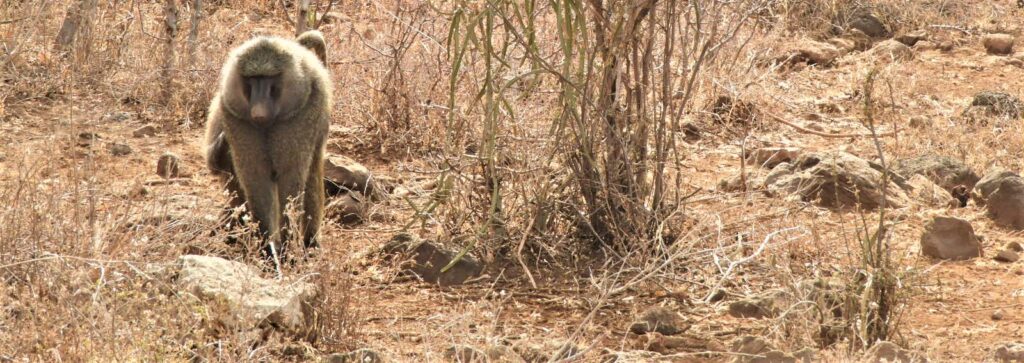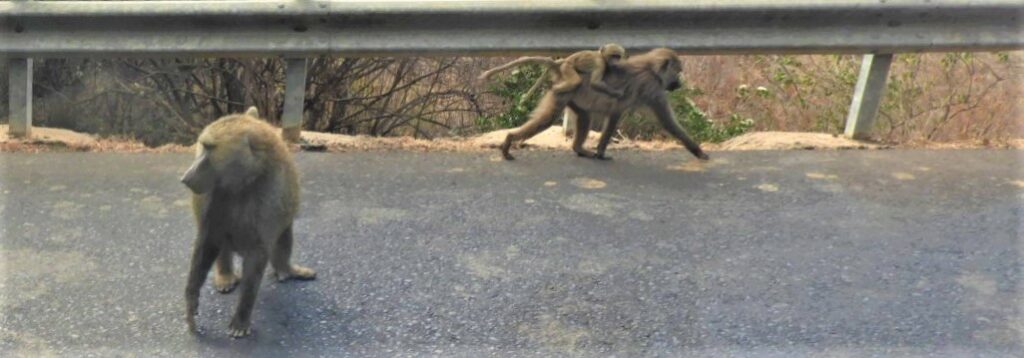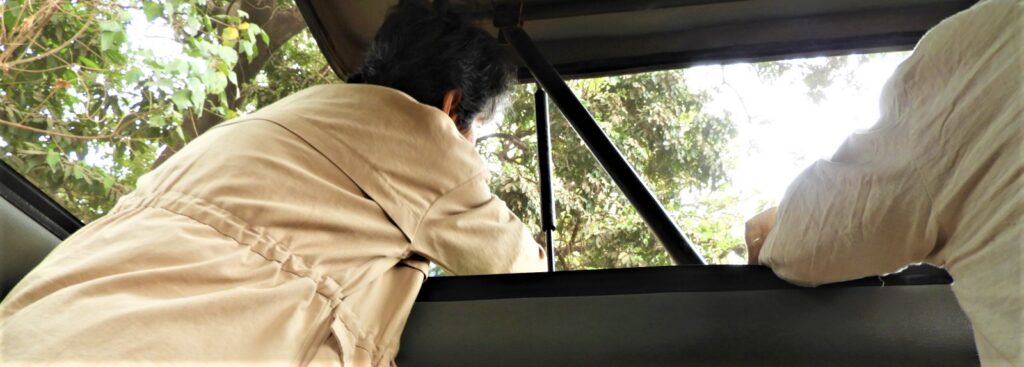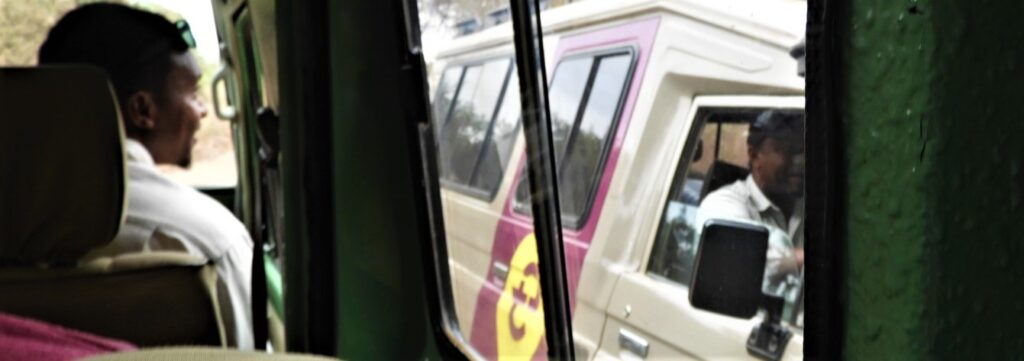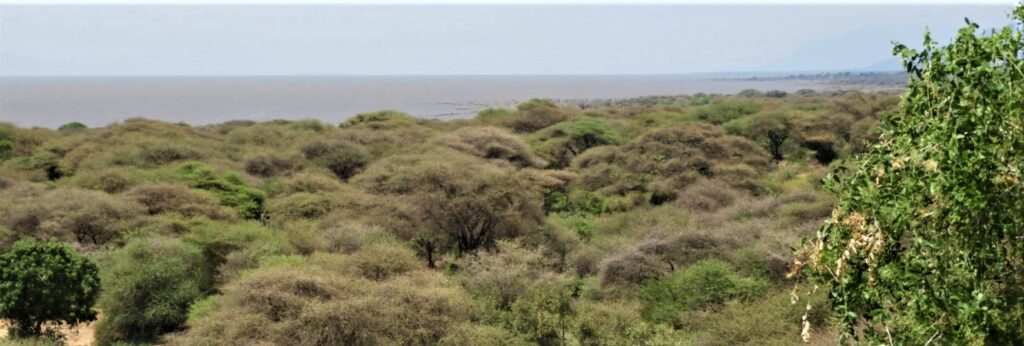» posted on Tuesday, September 20th, 2022 by Linda Lou Burton
Quickies: The Park
Linda Lou Burton posting from Lake Manyara National Park, Tanzania– Tree-climbing lions! That was enough to get up early for. And no long drive to get there; heck, the Park was 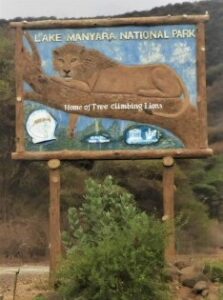 just at the bottom of the hill. Ten minutes to THERE. Out the gate of the Lodge, down the hill a thousand feet; into the gate of the Park. Easy Peasy Game Drive, no sloshing through mudholes and bumping across rocky plains. Just go. Ben the guide, Willy the driver, Otis and Venita row 2, Rick and me row 3, Judy row 4, along with the cooler and water supply. We were packed and ready. First animal spotting going down the hill: baboons, owning the road, babies, early morning action. The Park Gate, fees paid; top up on the 4×4, Judy and Rick standing up, looking out, scanning the trees for lions. Willy chatting with another driver, morning spotting so far? Baboons everywhere, bushes, vines; underbrush thick. Trees, dying trees, dead trees, four buffalo in the mud. Trees, sit and watch
just at the bottom of the hill. Ten minutes to THERE. Out the gate of the Lodge, down the hill a thousand feet; into the gate of the Park. Easy Peasy Game Drive, no sloshing through mudholes and bumping across rocky plains. Just go. Ben the guide, Willy the driver, Otis and Venita row 2, Rick and me row 3, Judy row 4, along with the cooler and water supply. We were packed and ready. First animal spotting going down the hill: baboons, owning the road, babies, early morning action. The Park Gate, fees paid; top up on the 4×4, Judy and Rick standing up, looking out, scanning the trees for lions. Willy chatting with another driver, morning spotting so far? Baboons everywhere, bushes, vines; underbrush thick. Trees, dying trees, dead trees, four buffalo in the mud. Trees, sit and watch 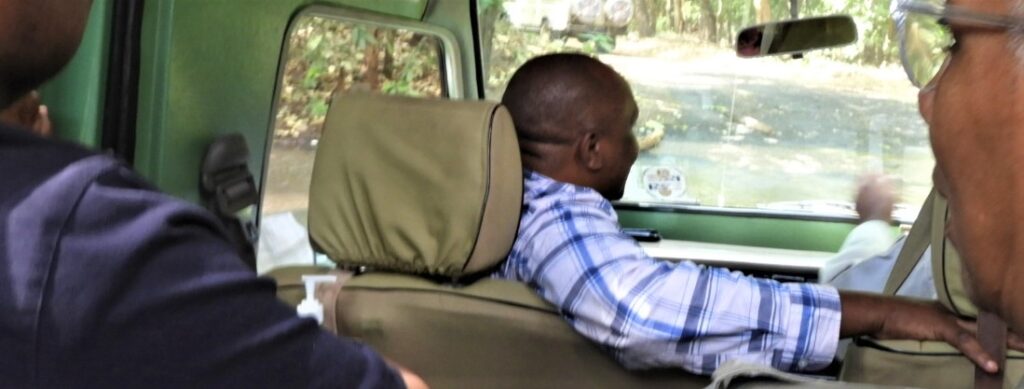 and wait for lions. Ben talking, telling stories, childhood lessons his mother taught. Time dragging. We were bored. Nuts! I remembered the nuts! The chocolate covered already gone; ha, wasabi peanuts left. I passed the bag around. No thanks, no thanks, nobody wanted wasabi heat. Except Willy. And then the scream! “Hot! Hot! Water! Water!” Excitement, finally, and then a brag. As Willy sucked the water down, Rick (Watch this! he said) took a wasabi nut, chewed slowly, swallowed it down. We nodded, impressed (only I was close enough to spot the tears); looked around for lions again. An explosion! In the front of the 4×4! Foam spewing, the windshield turning white, Willy yelling, Ben jumping what was going on??? Is the 4×4 on fire? Did the radiator burst? Should we bail? Willy opened his door, threw the spewing fire extinguisher on the ground. Ben moving fast, is Willy hurt? Is anybody hurt? “I’m okay,” Willy said. “The fire extinguisher blew up.” He began wiping down the inside of the 4×4, busy, cleaning up. “I’m okay,” he said again. “The fire extinguisher just blew up.” We could see, Willy was fine. Ben checked all around the 4×4, got back inside. “The fire extinguisher blew up.” Willy said again. “I don’t know why.” It was very quiet. And then, a burst of laughter, hoots and swoops of laughter, “Oh Willy, Willy, it was that wasabi nut!”
and wait for lions. Ben talking, telling stories, childhood lessons his mother taught. Time dragging. We were bored. Nuts! I remembered the nuts! The chocolate covered already gone; ha, wasabi peanuts left. I passed the bag around. No thanks, no thanks, nobody wanted wasabi heat. Except Willy. And then the scream! “Hot! Hot! Water! Water!” Excitement, finally, and then a brag. As Willy sucked the water down, Rick (Watch this! he said) took a wasabi nut, chewed slowly, swallowed it down. We nodded, impressed (only I was close enough to spot the tears); looked around for lions again. An explosion! In the front of the 4×4! Foam spewing, the windshield turning white, Willy yelling, Ben jumping what was going on??? Is the 4×4 on fire? Did the radiator burst? Should we bail? Willy opened his door, threw the spewing fire extinguisher on the ground. Ben moving fast, is Willy hurt? Is anybody hurt? “I’m okay,” Willy said. “The fire extinguisher blew up.” He began wiping down the inside of the 4×4, busy, cleaning up. “I’m okay,” he said again. “The fire extinguisher just blew up.” We could see, Willy was fine. Ben checked all around the 4×4, got back inside. “The fire extinguisher blew up.” Willy said again. “I don’t know why.” It was very quiet. And then, a burst of laughter, hoots and swoops of laughter, “Oh Willy, Willy, it was that wasabi nut!”
There’s nothing like a catastrophe to bond people together. We forgot about the lions, and the overall lack of animal spotting. We did see ONE fierce animal for the day. Ben noticed two tiny gazelles shivering nervously in the brush; his eyes looking past the vines, he whispered  “Willy, stop!” A python curled there, swollen, huge. “A gazelle inside,” Ben said; “two grieving gazelles back there.” We sat and watched for a bit, but a python full of gazelle doesn’t move a lot. Our animal count for three hours in the Park: 1 python; 3 gazelles, 1 hidden in the python; 4 buffalo in the mud, 15 baboons hiney-end up. Star of the morning: wasabi nuts. Fire!
“Willy, stop!” A python curled there, swollen, huge. “A gazelle inside,” Ben said; “two grieving gazelles back there.” We sat and watched for a bit, but a python full of gazelle doesn’t move a lot. Our animal count for three hours in the Park: 1 python; 3 gazelles, 1 hidden in the python; 4 buffalo in the mud, 15 baboons hiney-end up. Star of the morning: wasabi nuts. Fire!
A few photos of our Quickie Morning Park Visit and the road in.
Yes, we had our own story to tell!
Lake Manyara National Park https://www.lakemanyaranationalparks.com/
Lake Manyara National Park is a protected area between Lake Manyara and the Great Rift Valley, administered by the Tanzania National Parks Authority, and covering an area of 80,000 acres. It is part of the much larger Lake Manyara Biosphere Reserve, established in 1981 by UNESCO as part of its Man and the Biosphere Programme.
Lake Manyara is a shallow alkaline lake at an altitude of 3,150 ft, formed in a depression in the Rift Valley System. When full, the lake is a maximum of 10 ft deep and covers two-thirds of the park. The lake has no outflow, but is fed by underground springs and several permanent streams. In extreme dry periods the lake shrinks as the waters evaporate and at times has dried up completely. Beside the lake are extensive marshlands, saline flats (that expand as the surface area of the lake shrinks) and a grassy floodplain. Near the park gate  is a tall forest, sustained by groundwater, dominated by evergreen fig and mahogany trees. On the west side of the park, the rocky escarpment of the Rift Valley wall rises steeply to 6,000 ft. Large African baobab trees are scattered on the slopes and dense acacia woodland grows at the base of the Rift wall.
is a tall forest, sustained by groundwater, dominated by evergreen fig and mahogany trees. On the west side of the park, the rocky escarpment of the Rift Valley wall rises steeply to 6,000 ft. Large African baobab trees are scattered on the slopes and dense acacia woodland grows at the base of the Rift wall.
More than 390 species of birds have been documented in the Park, although in the dry season flamingos and other water birds are found in small numbers. Herbivores in the Park include zebra, bushbuck, waterbuck, Grant’s gazelle, impala, Thomson’s gazelle, Cape buffalo, giraffe, hippopotamus, baboon, warthog, and elephant. Predators in the Park include lion, leopard, African wild cat, spotted hyena, jackal, bat-eared fox, serval, honey badger, and mongoose. Cheetah and African golden cat are sighted occasionally.

